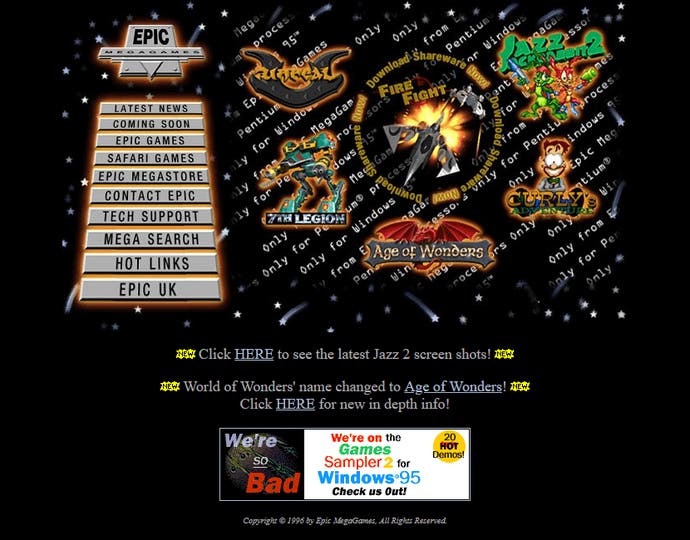Revisiting the first video game websites from the dark ages
"It's a bit of a lost art..."
In 1997, Diablo was everything to me; I thought about it at school, at family dinners, netball practice, recess. Even when I was allowed to play it on my dad's Gateway 2000, I wanted more. And the only place to get more Diablo, back then, was on the Diablo website. Yes, there were fan sites packed with cheats and the same gifs - but what I wanted was a pure unadulterated hit from the official webpage, its message boards filled with poetry and oddly civil flame wars and passive-aggressive posts titled "SUGGESTIONS for Blizzard to Read." There was no YouTube or Discord or Twitch, and certainly no influencer/streaming ecosystem. Sure, there was IRC and usenet and bulletin boards, which formed the backbone of social networks back then - and were the foundation for more accessible World Wide Web experiences that followed. But in the late 90s, there was something truly special going on for fans who wanted a direct connection to their games: the short-lived but holy institution of the official forum-based website.
Around the same time as my Diablo mania, a teenaged Dana Nightingale was asked to do her first professional web design job. She'd been a fan of Looking Glass Studios since Ultima Underworld came out in 1992; when she heard rumours of System Shock 2, a new shooter by ex-Looking Glass devs under the banner of Irrational Games, she and a friend made a fan site in anticipation of its existence. Nightingale was also waiting for Looking Glass to unveil Thief: The Dark Project. "[Thief] at the time was my most anticipated game by a long shot, and if you look at the landscape of 1998, that's saying a lot," she says. "So together with some other folks, we made a hub for fans of these games, and we called it Through the Looking Glass."
Irrational got in touch with Nightingale to make their sites. "I definitely wasn't even 20 at the time. I barely knew what I was doing," she says on a Zoom call. "I threw some HTML on there, took the copy they sent me - didn't know back then that it was called copy - and put it all together." For System Shock 2, the only visual she was given was a picture of Shodan's face. "I [had] to make everything based on just one image, that's all I had," she laughs, pointing to the website's splash page while sharing her screen. Today, Nightingale is level design director at Arkane Lyon, where she's worked for the past 13 years; a week before our chat, she'd unearthed the original Irrational website files by accident on an old hard drive. "I don't even remember how much [Irrational] paid me," she grins, "but it probably wasn't very much."
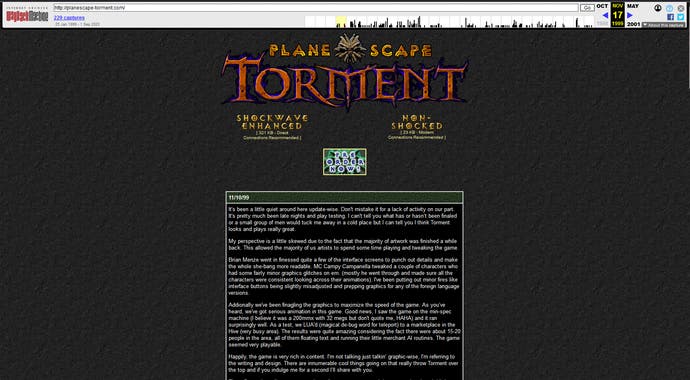
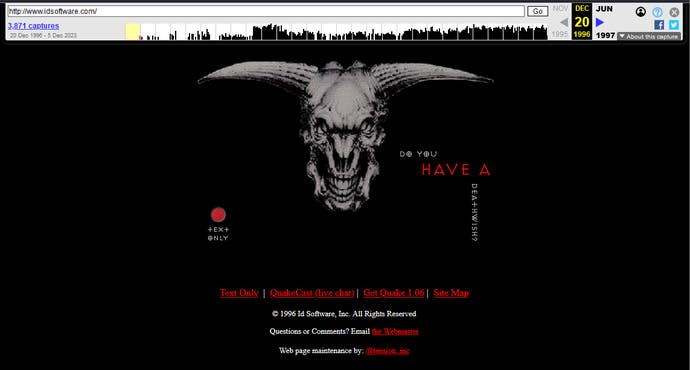
It's easy to see at the time how the division between fan pages and official game sites was a porous, paper-thin membrane. This was, after all, the dawn of the personal website, and the fact that everyone was cobbling pages together for businesses using the same DIY approach was a defining part of the era. But in the days of glacial dial-up and HTML-based web design, the relationship between players and devs was something else altogether. It wasn't just about being able to download new patches and mods from the "source," nor was it just about shareware, which Scott Miller had adapted so successfully to video game releases in the late 80s. It was about going to a tangibly "real" website to talk to other players and look at screenshots and read developer's diaries, when websites still had novelty both as a quasi-storefront and window into the studio itself. The Diablo site, with its original splash image of a ruined Tristram, was a virtual outpost that I'd visit after school and calculate how long it would take to download a 25MB file at 28.8kbps before my parents descended on me.
I can visit the fossilised remains of these sites on the Web Design Museum, which links to the Wayback Machine, and showcases dozens of bygone video game websites including id Software's mid-90s catalogue, Westwood Studios, Sierra On-Line, shareware pioneers Apogee/3D Realms, and of course, the original Battle.net. Looking back at my most formative period of gaming through the lens of web 1.0 personal webpage aesthetics is like peering into a forgotten, still-beloved dimension. One of single-image splash pages, and liberal applications of the Javascript onmouseovers that blew my simple child's brain into smithereens every single time it happened. In 1997, the Oddworld website, which used Adobe Flash, was one of the most fascinating objects I'd ever seen, with its deafeningly loud sound effects blaring out of my parents' chunky plastic Creative speakers. And I wasn't alone - this was a milestone period for so many of us, on both sides of the screen.
Obsidian's studio design director Josh Sawyer got his start in games by making the Planescape Torment website in 1999. Like Nightingale, Sawyer taught himself HTML by looking at other websites, copy-and-pasting code, and learning how it worked; when he started university in Wisconsin, they were just starting to let people host web servers - students each got half a megabyte of personal storage space - which he describes as a "technically challenging" time for the school's IT department. "I did eventually get a few books to look at for JavaScript and things like that, but for most things, I would just see a site and look at how they did things," he says. While bartering web design work for tattoos, Sawyer learned Flash, which became handy when he applied for a job at Interplay. The job turned out to be for a web design role at Black Isle Studios. "One of the reasons I was hired is because they said, of 62 applicants, only three had experience with Flash," he recalls.
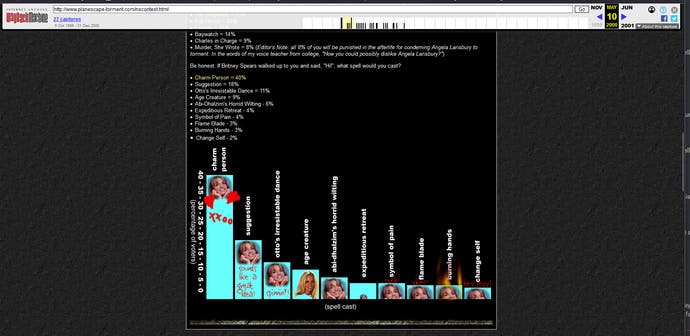
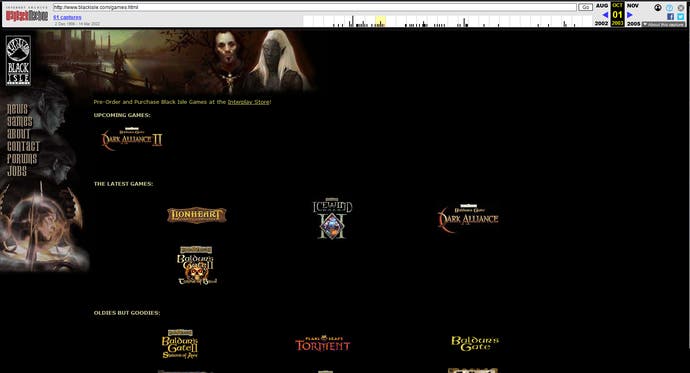
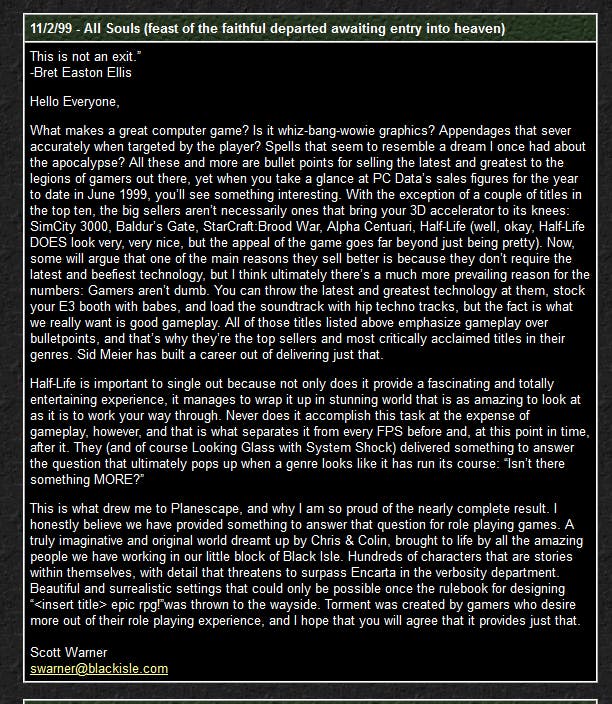
Sawyer also became the site moderator, working with the Planescape Torment developers to make site updates. "So while individual members of the development team would write updates, I would also write intro updates and weekly stuff, just kind of being the connection between the team and the audience on a day-to-day basis," he recalls. "I was interacting with most of the leads on the team and they all saw [the website] as a very important part of just getting out news, and engaging with the community, and getting people hyped on the game, and the team was also just really excited to share that stuff," he says of Planescape Torment.
The dev team made casual blog posts and signed off with their direct email addresses; it wasn't unusual at the time for studios to list direct contact information, physical street addresses and phone numbers on their sites, and Apogee even had a camcorder placed in the studio with a live feed. There was also no way to really advertise events and things on the fly, and Sawyer recalls one day making a last-minute banner that went on top of all the Interplay sites with a cow spinning end over end. "When it stopped, it had a little speech bubble saying 'hey, we're going to have [an IRC live chat] tonight'," he says. "And it actually worked pretty well."
1999 was also when Jay Tholen (Hypnospace Outlaw, Dropsy the Clown) finally got the internet, two years after he persuaded his parents to get a computer; he'd spent the time fantasising about the oft-romanticised "information superhighway" and created an offline pseudo-web for himself via thrifted CD-ROMs. "I had these '1001 Game Collections' that you'd get at Walmart... and they would have really bad stuff that someone swiped from the internet," he says of his early efforts collecting shareware and unregistered game demos that were sometimes full of viruses. "Every time I went to the store, I tried to get a magazine about the internet more than games, really, and I would just read about the web and the internet and daydream about it. I'd draw little pictures of browsers and what I imagined it was like." Using the offline pages included in these CDs, Tholen collected the HTML files and images in a folder that he labelled "the internet."
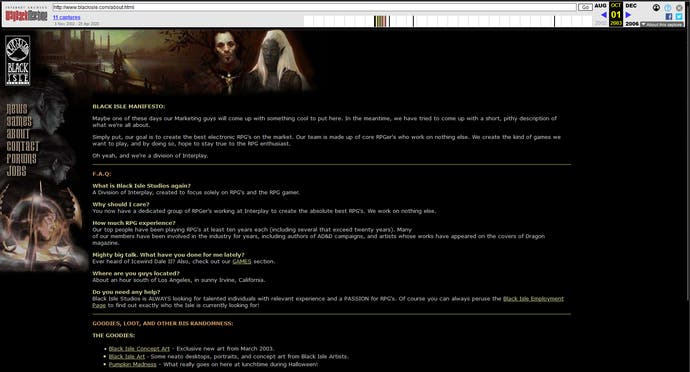
When Tholen finally got online, he tried to "make a web page" by uploading an MS Paint file. "It was just a bitmap file, but I thought once you uploaded it, the links would start working," he says with a laugh. He was quick to engage with video games through their websites - the first one he signed up for was TheSims.com, ready to unleash his carefully-prepared username of 'Simdroid052' on player forums. "It wouldn't let me, because the word 'droid' was part of Star Wars, which, way back in '99, is kind of crazy," he recalls. "That first website made me change my desired cool username to 'Simdrone052', which it did let me put in, so then I just had [that] as my username everywhere on the internet."
Next came the Klik & Play forum, and trawling for Duke Nukem Forever news on the Duke Nukem website; Tholen avoided posting on the latter because he was worried his parents might realise that Nukem was full of swearing. "I tried to download a clip of...a trailer or something that they put out for Duke Nukem Forever, maybe in 2000 or '99," he says. "But we were on dial up until 2011 - I went to the library sometimes to get files but I was unsuccessful in my many nights of trying to download this clip of Duke Nukem Forever."
Limited bandwidth was a major factor that Josh Sawyer and Dana Nightingale had to take into account at the time, since most people weren't logging on with ideal connections. Sawyer made two versions of the Planescape Torment - a heavyweight Flash one, and a standard HTML site for the majority of people with dial-up modems. "We were mostly looking at other sites that used Flash," says Sawyer of how the studio wanted to approach the website at the time. "We were so driven by the idea of 'gotta use the new tech'... that it was more like [we would] find any website that we [thought] was doing something visually, or from an audiovisual perspective, impressive, because it took so very little to impress in that time."
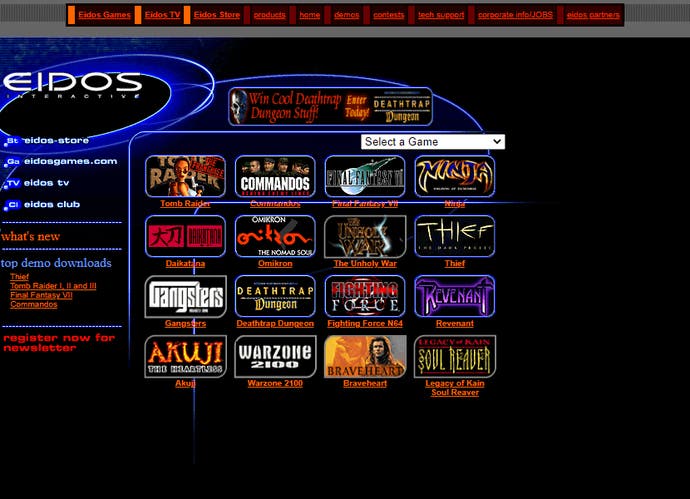
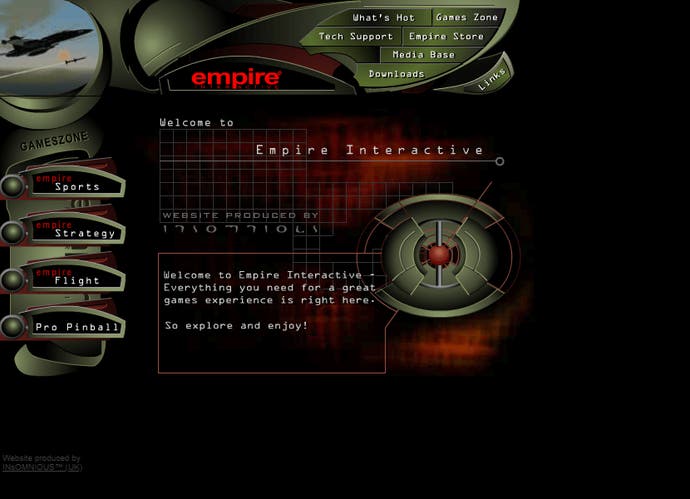
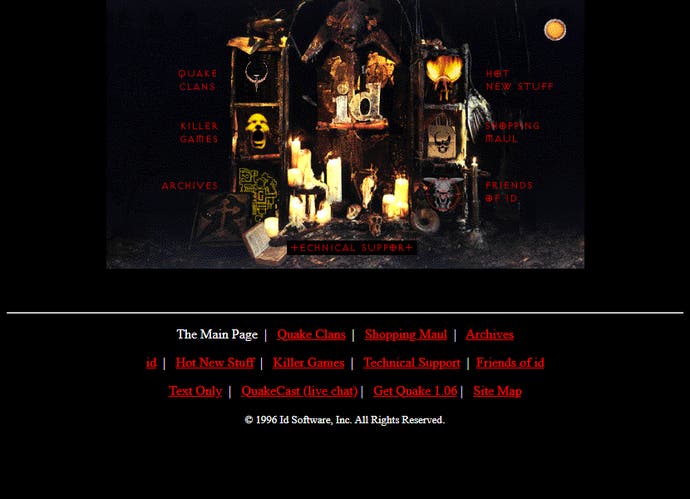
Nightingale recalls her first encounters with Flash as mostly being wowed by 256-colour images, which was a big deal. She was an avid Star Wars: Dark Forces player who visited loads of fan sites, and the ability to download new missions and levels ("they weren't called mods back then") promptly was crucial. "No one had anything faster than dial up back then... so Flash was like, get ready to have a bit of a wait for it to load," she says. "It was honestly exciting to see something that cool, but the novelty could wear off pretty fast. Sometimes it was nicer to get past the Flash presentation and get to the actual meat of the site so that the webpage would load in 10 seconds instead of 2 minutes."
In 2001, the holy grail of Flash video game websites arrived in the form of the Grand Theft Auto 2 site, and many fans retroactively consider these sites a defining part of the series' identity. HTML was now being supported by a new language called CSS (Cascading Style Sheets) to enhance web design, and company websites were becoming noticeably, visually slicker.
Sawyer's web design career continued with the Icewind Dale website (he also worked as a developer on the game itself), followed by a Baldur's Gate redesign, a new Baldur's Gate 2 site (which he also moderated), and finally, a very short lived Neverwinter Nights teaser site for Bioware. In his time as web designer, webmaster, and moderator, Sawyer's big takeaway was that being a lead designer on a project and a forum moderator was not a good mix. "People, especially when we go back to these small communities, because even if you tried to be - and I'm not saying I was always 100 percent chill and professional - but even if that is your goal and you pull it off, people carry grudges." As a result, the team made a user account that anyone could log into called "The Overseer," which he jokingly describes as "the faceless entity that was enacting justice" in the Interplay forums. "It was like the executioner's hood for the devs and other moderators, so that wouldn't spill over into other places," he says.

As for Tholen, his early relationship with the internet has carried on through his work - his next game, Dreamsettler, is a successor to the 90s-themed internet simulator Hypnospace Outlaw. It's one of the most overtly romantic and wonderfully sentimental games about a formative era for my generation, and it's easy, after speaking to Tholen, to see why. "In those couple years before I got the web, I was dreaming about it, and my head was full of the marketing that they did for the internet... and the metaphors [about] what this was supposed to be," he says. "And then when I got on it, I remember disappointment and a long process of figuring out HTML, because in the early days you couldn't do anything without knowing HTML, then making some crusty pages and signing up on the not-so-well moderated forums. Then now I look back and I'm like no, it was a lot better, in many ways. It's not as useful - it's getting less useful right now - but maybe five, ten years ago was a nice sweet spot."
It doesn't feel necessary to relitigate the role of nostalgia and sentimentality in design - trends and aesthetics have cycles, and history will always repeat itself in small patterns and reinterpretations and reinventions. But looking back at this oral history of web design and video games in the ‘90s - a time frequently described as "a wild west" by nearly everyone I spoke to - is also a stark reminder of lost optimism that the internet would one day bring us closer together. It's hard to say whether that's true today - depending on your preferred apps and networks and how you use them, your mileage may vary. The average person doesn't go to Nintendo.com or the official Bethesda site for new information - it's all YouTube and Twitter, and all official announcements are made through social channels.
The most shocking realisation in compiling this oral history was that this golden age of video game dotcom website supremacy - so historically, culturally and technologically significant - was barely a blip in time. These sites weren't just vehicles for information dissemination or marketing outreach, but dynamic, living entities that had to be tended to and fed and monitored by the devs. The result, for better or worse, was a level of intimacy and candid dorkery between players and devs that Discord can never replace. "Back then, it felt like forever, but if you look back, it was probably like four years tops when all this was happening," says Dana Nightingale. "It's a bit of a lost art."
